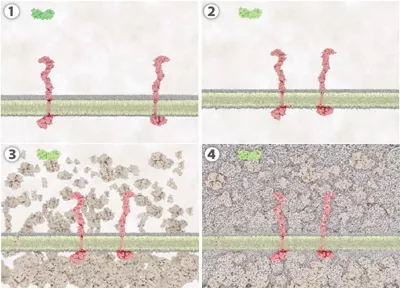
Communicating the molecular realm
Imagine a protein. That protein moves and the motions cause changes in its conformation—shape or structure. Within the protein, different parts of the protein move and conform differently and then, at the atomic level, vibrations, changes and motions occur.
From large conformational changes to the thermal vibrations of individual atoms, these different types of motion occur simultaneously.
“Our research is about helping undergraduate biology students to understand both the spatial and temporal scales associated with the molecular realm,” said University of Toronto Mississauga biomedical communications assistant professor Jodie Jenkinson.
In April, the Social Sciences and Humanities Research Council (SSHRC) recognized Jenkinson’s research with a $165,000 SSHRC Insight Award.
It all began with four 3D-animations of the same binding event between two molecules. Jenkinson, along with her co-investigator Gaël McGill, Director of Molecular Visualization at Harvard Medical School, increased the visual complexity of each iteration of the animation by adding details like straightforward motion, random motion, molecular crowding and molecular water.
The researchers randomly assigned UTM undergraduate biology students to one of four groups. They tested the students’ knowledge, showed them the animation, tested them again and two weeks later conducted a delayed test.
“Given what we know about cognitive load and theories of multimedia learning, we thought version four would be too complex,” said Jenkinson. In fact, the most complex version had the most lasting impact, said Jenkinson. However, this was limited to the more basic concepts.
The SSHRC award allows Jenkinson and McGill, to extend this research into understanding how to better design molecular visualizations to support depth of understanding over the long term. The award makes possible Jenkinson’s support of four biomedical communications master’s student and one M.Sc./Ph.D. student over the duration of the study.
“The SSHRC award allows us to look at visual variables over a period of four years,” said Jenkinson. “The same with our NSF grant.” Jenkinson is co-investigator on McGill’s $549,000 National Science Foundation Transforming Undergraduate Education in Science, Technology Engineering and Mathematics (NSF TUES) Grant.
In May, the University of Toronto awarded Jenkinson the $10,000 Connaught New Researcher Award to examine how students’ understanding of dynamic events are formed.
Previous work on the visualization of molecular interactions assumed that material had to be radically simplified—and, therefore, made inaccurate—in order to work with introductory audiences. Jenkinson's work suggests that researchers and educators may not have to sacrifice complexity or accuracy to achieve educational goals, said biomedical communications director, Professor Nicholas Woolridge. "This research will help define the next generation of visual education materials for undergraduate biology."
